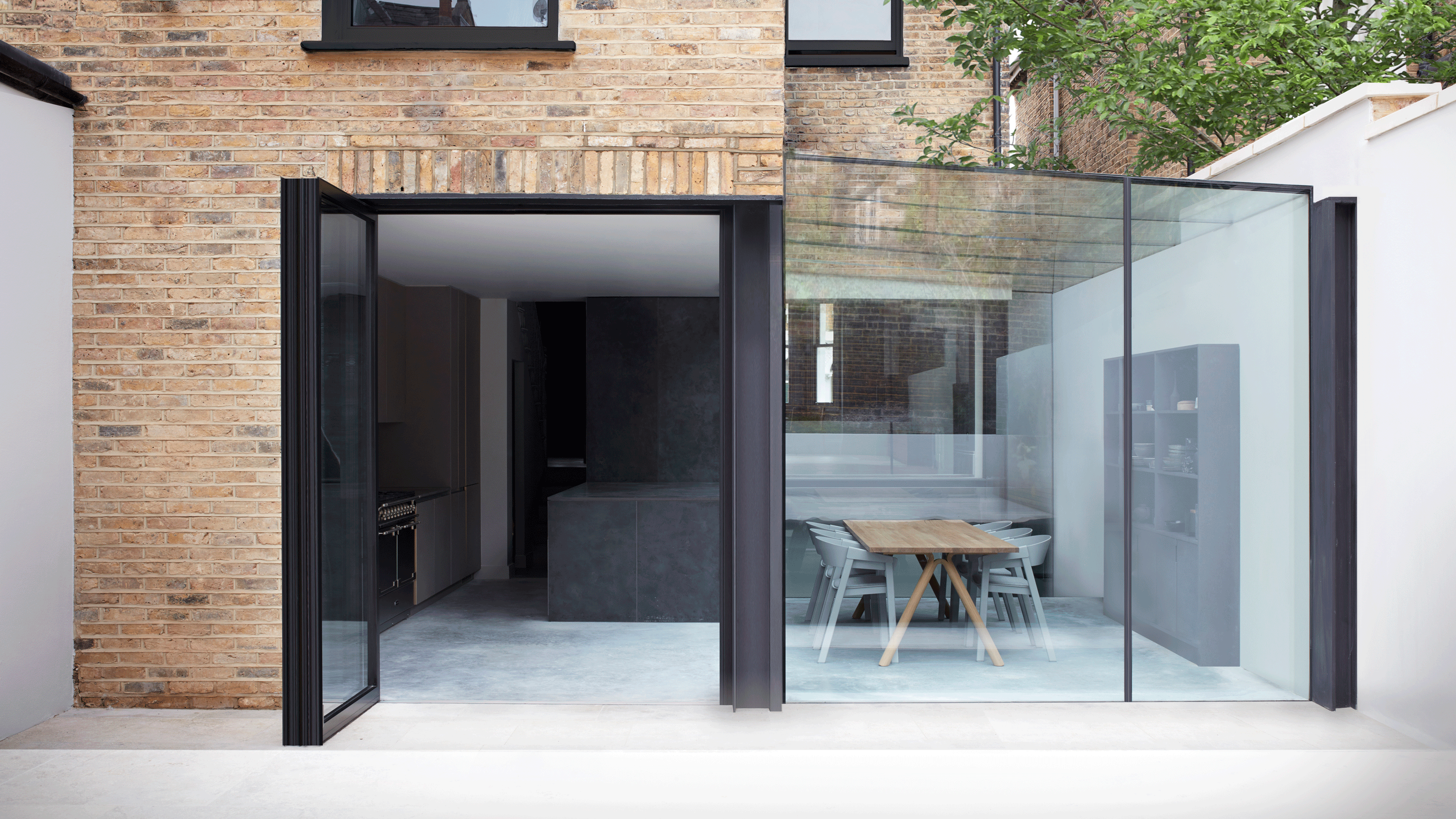A guide to glazing – everything you need to know about using glass in your home
Single, double, or even triple, the type of glazing you use in your renovation is key to a light-filled, airy space


Glazing may not instantly feel like the most exciting part of a renovation but it is a key part of making a space feel as light and airy as possible. Not just that, it is crucial to the warmth of your home and can make a big difference when it comes to heating costs.
Whether it is your windows, an internal door, or a large glass extension with bifold doors at the back of your kitchen to maximize your garden views, it is important to consider the best way to use glazing to make the most of the natural light streaming into your home. There is a lot to know about glazing before deciding what is best for you and here expert Emma Greene, associate director of glazing specialists IQ Glass gives a useful breakdown…
1. Know the difference between single, double and triple glazing

In order to know the right glazing for specific areas of your home, it is important to know the differences between them. ‘Single glazing is made up of a singular glass pane, with no insulation or thermal properties,’ explains Emma. However, it is the most cost-efficient and is easier to repair. It is also perfect if you are in a hot climate.
Double-glazing is more energy-efficient because you lose less heat and it is also one of the best ways to add value to your home. ‘Double glazed units are engineered with two panes and an argon gas cavity between the panes to create a well-insulated glass unit,’ says Emma. Triple glazing is the most expensive option. ‘It uses three panes of glass and has an even better thermal performance due to the extra gas cavity and glass pane.’
2. Double glazing saves a considerable amount of heating costs compared to single glazing

Single glazing provides no insulating properties whereas double glazed systems have a full thermal break as well as a gas-filled cavity to create highly insulated spaces and ensure the glass is not a source of heat loss. Single glazed external windows would require constant heating of the internal space, whereas double glazing will keep the heat in regardless of your type of heating and reduce the need for additional heating costs.
3. There are different types of glass options available

There are lots of modern design ideas with glass, but it is important to use the right glass for the right project.
‘Toughened glass is used in all of IQ’s products and systems as standard because they produce a more durable solution than standard float glass,’ says Emma. However, there are other glass types available for your project too. ‘Laminated glass can be specified and is provided as standard for all overhead or roof glazing, holding the glass in place in the event of a breakage.’
Low maintenance glass is great for hard-to-reach areas or coastal projects, where salt deposits in the air can settle on the glass surface. The low-maintenance glass creates an extremely smooth surface that makes it hard for any dirt to settle on.
Solar control glass is widely used for residential extension and new build projects with south-facing glazing, or large elevations of glass that could otherwise result in overheated internal living spaces. ‘Solar control coatings work by reducing the amount of short wave radiation that can travel through the glass and therefore reducing the increased heat levels, which can save on heating and cooling costs too,’ says Emma.
Low E glass stands for low emissivity and low e coatings are used to reduce the amount of heat that a glazing unit can absorb. These coatings are applied to most insulated glazing units and they improve the thermal performance of the glass unit.
4. Check the U and Uw value of your chosen glass to know how well insulated it is

A U value is used to indicate the heat loss through a material or installation. It is measured in W/m2K and when it decreases, less energy is able to travel through the material. ‘The lower the U value, the better and more efficient the installation is,’ says Emma.
‘Although the U value measures the performance of the glass, the Uw value is used to measure the performance of the glazing installation as a whole, which is why some glaziers will only offer the U value’.
When specifying glazing systems, you should be sure to ask for the Uw value for an accurate reading of how the window or door system will perform. For the best thermal performance, you want triple-glazed systems, as these will result in the lowest Uw values and provide the most insulated solution and is a good way to make your home more sustainable.
5. You can choose a glass with specific soundproofing qualities

Acoustic reduction glass can be specified within the glazing to reduce noise pollution in densely populated areas. The specialist acoustic interlayers will reduce the noise transmission by approximately 10 decibels by capturing the sound and preventing it from traveling past the glazing or inside the home.
6. Choose a good and reputable glass supplier

Always ask about the performance values and ensure technical information is widely available to you. Ensure when thermal performances are given they are referring to the whole glazing system and you are seeing a Uw value rather than U value.
‘Ask to see examples of previous projects to check what you are specifying will result in the design and appearance that you’re looking for. A reputable glazing supplier will consider all aspects of the installation, including watertightness and weather resistance rather than just the appearance,’ says Emma.
7. Know the price considerations for different types of glazing

The more layers to the glazing, the more expensive it will become, and the same for any technical glass solutions that are specified within the units. ‘Although this can increase the cost of the glazing, it will greatly reduce the cost of heating and cooling the home throughout the years,’ adds Emma. Oversized glazing has become extremely popular and has many benefits, including increased natural light and uninterrupted views, but will come with a higher price point.
What are the different types of glazing?
There are so many different types of glazing and the choice depends on where in the home you want to use it. Toughened glass for instance is a good option when there is a high risk of someone making contact with it, so recommended for doors and large windows. Laminated glass on the other hand is more resistant to breakage and works well for sound control. It is worth speaking to an expert before making a final decision.
Is it possible to fit your own glazing?
For the best results that will achieve the best performance values, always use an expert glazing fitter. Where experts are not used, the systems may not be installed correctly and the performance or insulation may be compromised.
Be The First To Know
The Livingetc newsletter is your shortcut to the now and the next in home design. Subscribe today to receive a stunning free 200-page book of the best homes from around the world.
As the Deputy Editor of Livingetc, Busola Evans works across both print and digital and specialises in kitchens, bathrooms and projects. She is an expert at explaining how to improve, extend and convert your home. Prior to her current role, she was Associate Editor on both Livingetc and Homes & Gardens. A journalist for more than 20 years, she has written for a number of newspapers and magazines including The Guardian, The Sunday Times Magazine and Grazia, and was an interiors columnist for the London Evening Standard's ES Magazine.
-
 5 Habits to Adopt That Will Make Your Home Smell Good All the Time — 'Add Them to Your Routine Today!'
5 Habits to Adopt That Will Make Your Home Smell Good All the Time — 'Add Them to Your Routine Today!'Incorporating these tricks into your maintenance routine will keep every corner of your home smelling fresh and welcoming
By Katie Baxter Published
-
 7 Ways Expert Organizers Reduce Visual Clutter in the Kitchen — 'They're Virtually Effortless!'
7 Ways Expert Organizers Reduce Visual Clutter in the Kitchen — 'They're Virtually Effortless!'Follow these expert tips to reduce the cluttered look in your kitchen and create a visually harmonious space perfect for hosting
By Imogen Williams Published

